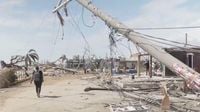Nearly a week has passed since Hurricane Melissa, a catastrophic Category 5 storm, tore through the Caribbean, leaving a trail of devastation that has touched nearly six million lives across Haiti, Cuba, and Jamaica. As the full scale of the disaster comes into focus, stories of destruction, resilience, and urgent recovery efforts are emerging from every corner of the region.
Jamaica, in particular, has been thrust into the spotlight, grappling with the aftermath of what the National Hurricane Center described as the most powerful hurricane to strike the island in 174 years. The storm made landfall near New Hope on Jamaica’s southwestern coast on October 28, 2025, unleashing winds that reached a staggering 185 mph (295 km/h). The eyewall carved a path of destruction across the western part of the island, flattening homes, stripping mountains bare, and leaving entire communities isolated and without power.
According to UN News, the World Food Programme (WFP) has launched a sweeping emergency operation, distributing food kits to the hardest-hit families and airlifting additional supplies from Barbados. “Our priority right now is to reach the most isolated communities,” said Alexis Masciarelli of the WFP, speaking from Kingston. So far, 1,500 people in Jamaica have received food kits containing rice, lentils, canned fish and meat, and vegetable oil, with another 2,000 kits on the way. The WFP aims to assist up to 200,000 Jamaicans in meeting urgent food needs.
The devastation in Jamaica’s St. Elizabeth parish, long considered the country’s breadbasket, has been especially acute. Homes, farms, and livelihoods have been destroyed, and many communities remain cut off, without power or reliable communication. The situation in the countryside is dire, as echoed by Jamaican music superstar Sean Paul, who told BBC News, “It is overwhelming. I myself took a drive to the country yesterday, the countryside of St Mary, which was not hit as hard, but still hit. They don’t have light yet, and a lot of people out there can’t even see the rest of what’s happening, because once they get charge on their phone, they’re just trying to call loved ones to make sure that they’re OK.”
Paul, who weathered the storm in Kingston with his family, described the hurricane as “very frightening, especially for my young kids.” He added, “That’s the first time they’ve seen trees dance like that and the wind move like that. They’re in shock still, and traumatised. And can you imagine the children who are in the epicentre of it? It feels like you’re in the Middle Ages.” The Grammy-winning artist has since pledged $50,000 to match donations to Food For The Poor Jamaica, underscoring the urgency of the relief effort.
His friend and fellow musician Shaggy has also been on the ground, coordinating aid convoys and planning a benefit concert for December. “Devastated. I don’t think I can unsee what I’ve seen... It’s rough, there’s a lot of aid coming in. Nobody could really prepare for something like that,” Shaggy said. “We got into the Black River area, which was hit really hard. Everything is flattened. It breaks my heart. I couldn’t help but weep. These are my people.”
Jamaica’s government, led by Prime Minister Andrew Holness, has been racing to respond. On November 3, the official death toll stood at 32, with the prospect of eight more unconfirmed deaths. “The scale of destruction is unlike anything we have seen in decades,” Holness wrote after touring devastated areas, as reported by FOX Weather. The government, in collaboration with the U.S. State Department Disaster Relief Task Force, has begun reaching the most devastated communities, delivering the first wave of aid supplies and fuel to Westmoreland Parish. Search and rescue missions are ongoing, with U.S. teams supporting Jamaican emergency services. Helicopter food drops and medical airlifts have been conducted in the hardest-hit areas, as the Jamaican Defence Force and international partners strive to reach those still stranded.
Yet, the road to recovery is fraught with challenges. Many roadways are blocked by downed powerlines, and nearly half of all power customers in western Jamaica remain without electricity. Communication breakdowns persist, making it difficult for aid agencies and government officials to assess needs and coordinate relief. “The main challenge ahead is reaching people in the last mile – those who need help the most in areas that remain inaccessible,” said Masciarelli of the WFP. The agency has launched an urgent appeal for $74 million to deliver life-saving assistance to up to 1.1 million people across the Caribbean.
The impact on Jamaica’s economy is significant, particularly as the island’s crucial tourism season approaches. Before the hurricane, officials expected tourism to grow by 7% this winter, with 4.3 million visitors anticipated. Now, the focus is on rebuilding hotels and clearing debris in the western region to secure much-needed tourist dollars. Christopher Jarrett, head of the Jamaica Hotel and Tourist Association, told AP that while some major hotel chains are on track to recover by December 15, smaller businesses face a tougher road ahead. “Every individual member who was affected is doing everything to get back up and running,” Jarrett said. Many hotels in Kingston and Ocho Rios are housing aid workers and volunteers, providing a temporary economic lifeline.
Still, the disruption has left thousands without work. “With some of the hotels closed and most of the tourists gone, many of us are left without work. This storm didn’t just destroy buildings; it shattered jobs and incomes for many of us and our families,” said Patricia Mighten, a hotel housekeeper in Hanover. Desrine Smith, a craft vendor in Falmouth, echoed the hardship: “Going days without tourists coming to buy anything means no sales and no money. We survive on daily earnings, and now everything is uncertain. The hurricane has impacted our pockets hard.”
Elsewhere in the Caribbean, the scale of the disaster is equally harrowing. In Cuba, widespread flooding and power outages have forced 181,000 people into shelters, with WFP food distributions reaching those most in need. The agency plans to assist 900,000 Cubans in the coming weeks. In Haiti, the southern coast has been devastated, with homes and infrastructure washed away. Emergency food distributions have reached 12,700 people in the Grand Sud region, and a combination of food rations and cash assistance is being rolled out for 190,000 Haitians.
As the Caribbean embarks on what WFP’s Masciarelli called a “very long marathon recovery period,” the challenges are immense but not insurmountable. Aid continues to trickle in from governments, charities, and international organizations, and the resilience of local communities is on full display. The coming weeks and months will test the region’s resolve, but for now, the focus remains on saving lives, restoring livelihoods, and rebuilding what Hurricane Melissa has torn apart.


